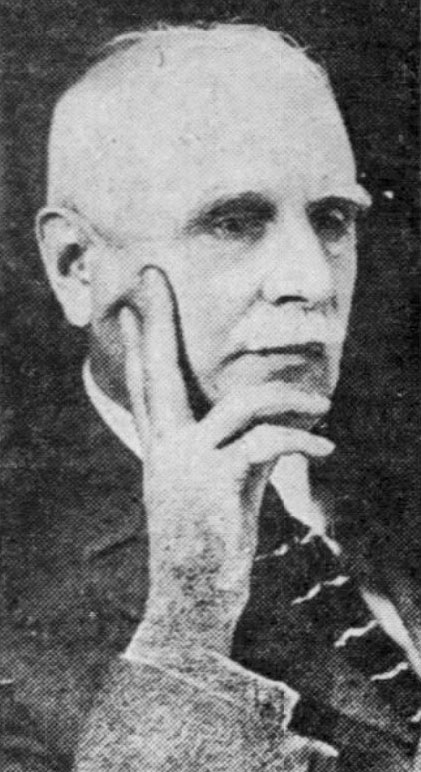Robert Hall Babcock, MD, 1851-1930
By Emma Florio, Archives & Research Specialist
Robert Hall Babcock was born on July 26, 1851, in upstate New York. His family relocated to Kalamazoo, Michigan, shortly after his birth. At age 13, Babcock was playing with his younger brother, who had fashioned a toy gun out of a large key; like many boys during the Civil War, they often played soldiers. Not finding this exciting enough, they decided to create a bomb by putting gunpowder in a food tin. When the improvised bomb didn’t explode after lighting it, Robert blew on the powder, and it exploded in their faces. His brother was unharmed, but Robert’s eyes were damaged, and he was permanently blinded.
 |
|
Babcock, ca. 1895. From the Tri-State Medical Journal, vol. 2, no. 10
|
At first, Babcock’s family coddled him, but his mother quickly realized that such treatment would make him dependent on others and unable to care for himself. After consulting with experts across the country, she decided that Robert should go to an institution for the blind. From 1865 to 1867, he attended the Pennsylvania Institution for Instruction of the Blind in Philadelphia. Students at the school learned to read using books with raised letters, which Babcock never took to—he would always prefer to have people read to him, relying on his sharp memory to retain the information. He later attended the preparatory department of Olivet College in Michigan and Western Reserve College in Ohio, neither of which specialized in the education of blind students. Later in life, Babcock reflected that being in contact with sighted students allowed him to challenge himself and discover what he could really do.
After a period of indecision following his undergraduate studies, Babcock chose to pursue a career in medicine. He first attended the Ann Arbor Medical College (now University of Michigan Medical School) and then transferred to Chicago Medical College (precursor to Feinberg School of Medicine) in 1876. With the help of his fellow students, he was able to pass classes like anatomy, which relied more on visual learning. What he could not feel with his hands, his classmates were able to explain to him. He earned his MD in 1878, graduating third in his class. He continued his medical studies at Columbia University’s College of Physicians and Surgeons, where he earned another degree in the spring of 1879. Shortly afterward he married Lizzie Weston, with whom he would eventually have three children.
Babcock returned to Chicago and found work giving quizzes to students at Chicago Medical College. He thought he might specialize in obstetrics, because it relied more on touch than on sight. Edmund Andrews, a founder of CMC and professor of surgery at the school, suggested in a similar vein that he concentrate on diseases of the heart and lungs, which depended on a keen sense of hearing. Babcock and his wife traveled to Germany so he could study with the leading specialists in this field. In 1883, the family returned to Chicago where Babcock set up his medical practice.
 |
|
Babcock, ca. 1930. From the Chicago Daily Tribune, June 29. 1930.
|
Babcock was slow to find success in his private practice. He relied on work in the throat and chest department of the Southside Free Dispensary of Chicago Medical College, where he treated patients and taught medical students. He saw few clients in his office and often passed the time having an assistant read the latest medical journals to him. In 1888 he helped to found the Post-Graduate Medical School of Chicago and three years later became the Chair of Clinical Medicine and Diseases of the Chest at the Chicago College of Physicians and Surgeons (now the University of Illinois College of Medicine). This role came with a position on the staff of Cook County Hospital, which helped bring him more patients.
The latter part of Babcock’s career was marked by much more success and by many firsts. In 1889, he became the first physician in the Midwest to accurately describe coronary thrombosis and infarction; in 1891 he wrote the first paper in the United States about the treatment of dropsy (a buildup of fluid in the tissues, now called edema) with Diuretin, an early diuretic drug; and in 1909 he was the first author to note the connection between gall bladder disease and heart problems, in an article that was still being cited decades later. His prominence as a physician led to his involvement with many medical organizations: in 1901 he was elected president of the American Climatological Association, a group which studied the climate and its effects on chronic respiratory diseases, and in 1904 he co-founded the National Association for the Study and Prevention of Tuberculosis, which evolved into the American Lung Association. Because of this high profile in his field, he was asked to write multiple textbooks for medical and lay audiences, including Diseases of the Heart and Arterial System (1903), Diseases of the Lungs (1907), and Your Heart and How to Take Care of It (1918).
Robert Hall Babcock died in 1930, at his summer home in Wisconsin. Reflecting his prominence in the medical community, honorary pallbearers at his Chicago funeral included notable men like Frank Billings, Arthur D. Bevan, Dallas Phemister, and Hugh T. Patrick. He was buried in Kalamazoo, under a gravestone with the epitaph: “In Darkness His Vision Held.”
Selected References
Beatty, William K. “Robert Hall Babcock: Acute Diagnostician and Physicians' Physician.” Proceedings of the Institute of Medicine of Chicago 37, no. 4 (Oct/Dec. 1984): 130-144.
“Dr. R. H. Babcock, Famous Heart Specialist, Dies.” Chicago Daily Tribune, June 29, 1930.
Hinsdale, Guy. “Memorial: Robert Hall Babcock, MD, LLD.” Transactions of the American Climatological and Clinical Association 47 (1931): xl-xli.
Updated: July 11, 2024